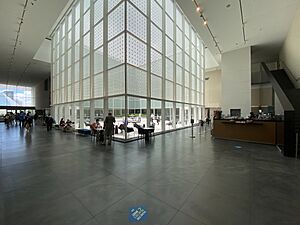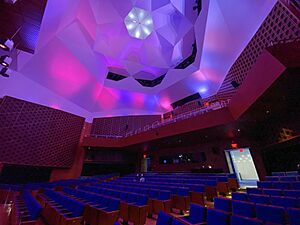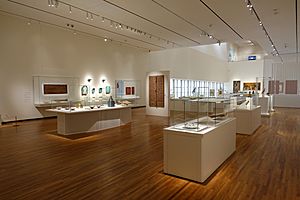Aga Khan Museum facts for kids

Exterior view of the Aga Khan Museum
|
|
| Lua error in Module:Location_map at line 420: attempt to index field 'wikibase' (a nil value). | |
| Established | September 18, 2014 |
|---|---|
| Location | Toronto, Ontario, Canada |
| Type | Muslim arts and culture |
| Collection size | 1,000 |
| Public transit access | |
The Aga Khan Museum is a special place in Toronto, Ontario, Canada. It's a museum that celebrates the amazing art and culture of Muslim communities from around the world. It has about 1,200 rare and beautiful objects collected by Shah Karim al-Husayni and Prince Sadruddin Aga Khan.
This museum wants to help people learn about Muslim cultures and how they connect with other cultures through art. Besides its main collection, the Aga Khan Museum also has new exhibits each year. These shows explore interesting topics and new art. The museum also offers fun educational programs and live performances.
Contents
History of the Museum
How the Museum Was Built
For many years, the Aga Khan, who is the spiritual leader of Ismaili Muslims, wanted to build a big museum for Islamic art. He wanted it to show how Islamic civilizations have connected with other cultures throughout history.
The museum's location in Don Mills, Toronto, was chosen in 2002. This happened after plans for a site in London, England, didn't work out. The Aga Khan chose Canada because it welcomes many different cultures.
He bought the old Bata Shoes Head Office building, which was next to the Ismaili Centre already being built. The old building was taken down in 2007 because it wasn't right for the museum. A famous architect named Fumihiko Maki designed the new museum building. The museum shares its large 6.8-hectare space with beautiful public gardens. These gardens were designed by Vladimir Djurovic.
The building project officially started on May 28, 2010. Canadian Prime Minister Stephen Harper and the Aga Khan were there for the special ceremony.
Art on Tour in Europe
While the museum was being built, some of its amazing art went on a special tour in Europe. People in many cities got to see parts of the collection.
- Palazzo della Pilotta in Parma, Italy
- Ismaili Centre in London, England
- Louvre in Paris, France
- Calouste Gulbenkian Museum in Lisbon, Portugal
- CaixaForum Madrid in Spain
- CaixaForum Barcelona in Spain
- Martin-Gropius-Bau in Berlin, Germany
- Sakıp Sabancı Museum in Istanbul, Turkey
- The Hermitage in St. Petersburg, Russia
These art shows were very popular around the world. They showed both the spiritual and everyday parts of Muslim cultures, which are closely connected. The first shows had two main themes: "The Word of God" (about religious texts) and "The Power of the Sovereign" (about Muslim rulers). Later shows focused on "The Word of God" and "The Route of the Travellers," showing how widespread the Islamic world is.
Museum Opening
The Aga Khan Museum officially opened its doors to the public on September 18, 2014. Michael Brand was the first director, followed by Henry Kim. Prince Amyn Aga Khan became the chairman of the board in 2016.
In 2016, the museum received an award for its exhibition called "Home Ground: Contemporary Art from the Barjeel Art Foundation."
Dr. Ulrike Al-Khamis became the director of collections and public programs in 2017. She was then appointed director and CEO in 2021. In 2017, the Aga Khan Museum Shop also started selling items online. Many of the items, like jewelry, books, and artwork, are made just for the museum. They often connect to the museum's exhibits and main collection.
The Aga Khan Museum was named one of the best museums in Toronto by Conde Nast Traveler in 2018. That same year, an exhibition called "The World of the Fatimids" won a Global Fine Art Award. Another exhibition, "Skate Girls of Kabul," also received an honorable mention. In June 2018, Chef Shen Ousmand launched a new menu at the museum's restaurant, Diwan.
A new subway stop called "Aga Khan Park & Museum" on Line 5 Eglinton is expected to open in 2025.
Museum Architecture
The Aga Khan Museum was designed by the award-winning architect Fumihiko Maki. It shares a large 6.8-hectare (17-acre) space with the Ismaili Centre, which was designed by Charles Correa. The beautiful park around them was created by landscape architect Vladimir Djurovic. It's like a modern version of a traditional Islamic courtyard, called a Charbaag.
Inside the museum, you'll find art galleries, special exhibition areas, classrooms, a library, an auditorium, and a restaurant. The museum's main collection has over 1,000 objects. These include rare masterpieces from more than ten centuries of history and many different places.
The Aga Khan wanted the museum building and its surroundings to celebrate light. The building is shaped like a rectangle and faces the sun at a special angle. This makes the building's white Brazilian granite surfaces look different throughout the day, with changing light and shadows. It's almost like a sundial.
Inside the museum, there's a peaceful courtyard. Its glass walls have a special pattern that looks like traditional Islamic screens called Jali. Light from the courtyard creates patterned shadows inside the building. On the second floor, four large openings look down into the public spaces. These openings have screens that look like modern Musharabiya, which are Islamic bay windows. In the galleries, large skylights with small hexagonal holes let in soft, natural light for the art.
Museum Collection
The Aga Khan Museum collects, protects, displays, and explains objects related to the ideas, culture, art, and religious traditions of Muslim communities. This includes things from the past and present. The collection has ceramics, metalwork, and paintings from all periods of Islamic history.
Some of the important items are old Manuscripts. For example, there's the earliest known copy of Avicenna's "The Canon of Medicine," which is from 1052.
The museum also keeps historical materials about the Ismaili community. It has research programs related to its mission. It's a place for Islamic and Western cultures to share ideas about education, culture, and social topics.
The collection has about 1,000 objects. This includes several beautiful examples of Qur'an manuscripts. These show the many different writing styles, materials, and decorations used in the Muslim world. One page from the famous Blue Qur'an is a great example. It has gold writing on dark blue parchment. The Blue Qur'an is considered one of the most amazing Qur'an manuscripts ever made. It's from the 9th or 10th century and was likely made for the Fatimid rulers.
On the museum's main floor, the Bellerive Room displays ceramics collected by the late Prince Sadruddin Aga Khan and Princess Catherine Aga Khan. This room looks like the "Persian Salon" from their home in Switzerland. About 60 ceramic objects are on display here. They are from early Islamic times up to the 17th century. Their styles show the new ideas and beautiful designs of Islamic potters over the years. These potters often took inspiration from places like China and Europe.
In 2018, a large sculpture called Big Heech by Iranian-Canadian artist Parviz Tanavoli was placed at the museum entrance. This sculpture was a gift to celebrate the Aga Khan’s Diamond Jubilee.
Special Exhibitions
The Aga Khan Museum often hosts temporary exhibitions that explore different themes and artists. Here are some examples:
- Home Ground: Barjeel Art Foundation Modern Arab Art Collection (June 15, 2015 – January 3, 2016)
- Abbas Kiarostami: Doors Without Keys (November 21, 2015 – March 28, 2016)
- Syria: A Living History (October 15, 2016 – February 26, 2017)
- Rebel, Jester, Mystic, Poet: Contemporary Persians (February 4, 2017 – June 4, 2017)
- Syrian Symphony: New Compositions in Sight and Sound (May 20, 2017 – August 13, 2017)
- Here: Locating Contemporary Canadian Artists (July 22, 2017 – January 7, 2018)
- The World of the Fatimids (March 10, 2018 – July 2, 2018)
- The Moon: Voyage Through Time (March 9, 2019 – August 18, 2019)
- Caravans of Gold, Fragments in Time: Art, Culture, and Exchange Across Medieval Saharan Africa (September 21, 2019 – February 23, 2020)
- Don't Ask Me Where I'm From (February 25, 2020 – October 11, 2020)
- Sanctuary (March 21, 2020 – October 25, 2020)
- 50 Years of Migration (January 24, 2023 – February 12, 2023)
- Rumi (May 13, 2023 – October 1, 2023)
- Cultured Pallets (May 2, 2023 – November 5, 2023)
The exhibition "Don't Ask Me Where I'm From" showed the experiences of artists who are immigrants or whose families immigrated. These artists grew up in a culture different from their parents'. Their artworks explored what it's like to live between different cultures.
The "Sanctuary" exhibition used rugs as a way to tell stories of immigrants. Thirty-six artists from twenty-two countries designed rugs. Artisans in Lahore, Pakistan, wove these designs using traditional methods. Famous artist Ai Wei Wei was one of the artists in this exhibition.
The "50 Years of Migration" exhibition celebrated over 50 years of Ismaili Muslims moving to Canada. It shared family photos, personal stories, and historical documents. It showed the bravery of many Ismaili Muslims who left their homes to find safety. The exhibition included stories from Canadian Ismailis from places like Uganda, Afghanistan, Syria, Tajikistan, India, and Pakistan.
See also
- Aga Khan Park
- The Ismaili Centre, Toronto
- Aga Khan Trust for Culture
- Aga Khan Development Network
- List of Islamic art museums
- List of museums in Toronto






